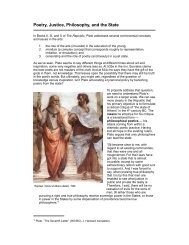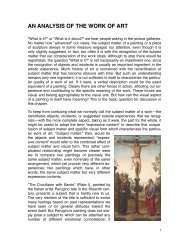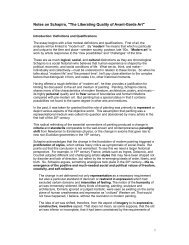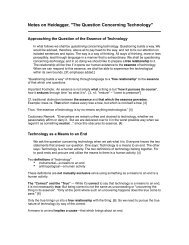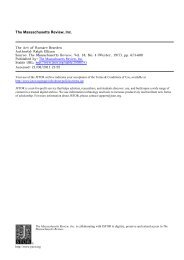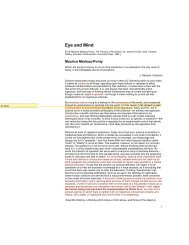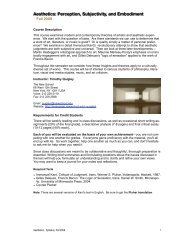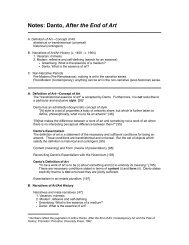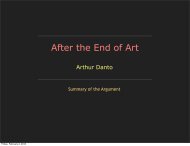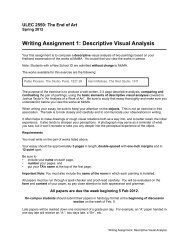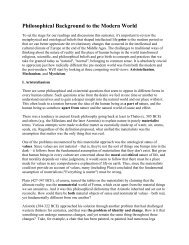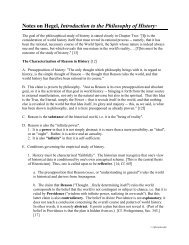âThe Liberating Quality of Avant-Garde Artâ - Timothy R. Quigley
âThe Liberating Quality of Avant-Garde Artâ - Timothy R. Quigley
âThe Liberating Quality of Avant-Garde Artâ - Timothy R. Quigley
You also want an ePaper? Increase the reach of your titles
YUMPU automatically turns print PDFs into web optimized ePapers that Google loves.
“The <strong>Liberating</strong> <strong>Quality</strong> <strong>of</strong> <strong>Avant</strong>-<strong>Garde</strong> Art”Meyer SchapiroSummary <strong>of</strong> the ArgumentTuesday, February 7, 2012
IntroductionMeyer Schapiro (1904-1996)"Art has its own conditions which distinguish itfrom other activities. It operates with its ownspecial materials and according to generalpsychological laws."Schapiro lived in Greenwich Village with hiswife, Dr. Lillian Milgrim, and lectured at TheNew School from 1936-1952.Tuesday, February 7, 2012
Introduction"The <strong>Liberating</strong> <strong>Quality</strong> <strong>of</strong> <strong>Avant</strong>-<strong>Garde</strong> Art"In this essay, Schapiro makes use <strong>of</strong>• formal visual analysis,• social history,• psychology, and• natural scienceto show how abstract painting and sculpture• embodies,• focuses, and• intensifieskey aspects <strong>of</strong> human experience and, in sodoing, expresses our fundamental values andideals.Tuesday, February 7, 2012
Modern Art: Basic Assumptions, Definitions, and QualificationsSocial History <strong>of</strong> ArtAs a social historian, Schapiro believes that human experience isshaped by the• political,• economic, and• social conditions <strong>of</strong> life.It follows that we must understand whatever human beings do, think, andmake — individually and collectively — in relation to these forces.When Schapiro talks about “modern life” and “the present time”, he paysclose attention to the complex factors that both distinguish this periodfrom, and relate it to, other historical moments.Tuesday, February 7, 2012
Tuesday, February 7, 2012Definitions and Justifications
Modern Art: Basic Assumptions, Definitions, and QualificationsDefinitions“Modern” is not just a chronological category — for Schapiro it marks• logical,• social, and• cultural distinctions.He defines “modern painting and sculpture” asthe work <strong>of</strong> artists who take seriously the challenge <strong>of</strong> newpossibilities and wish to introduce into their work perceptions, ideasand experiences which have come about only within our time. [1]Georges Braque, Large Nude, Paris,spring 1908Pablo Picasso. Les Demoiselles d'Avignon, 1907Tuesday, February 7, 2012
Modern Art: Basic Assumptions, Definitions, and QualificationsJustificationWith this provisional definition <strong>of</strong> “modern art”, Schapiro limits his discussionto one medium — painting.Is this an arbitrary decision? What justifies it?According to Schapiro, modern painting shares many <strong>of</strong> the characteristics<strong>of</strong> modern literature, architecture, poetry, and music.But painting has a special status in that it contains possibilities not foundto the same degree in other arts and mediums.Having said that, how does he convince the reader it’s true?Tuesday, February 7, 2012
Modern Art: Basic Assumptions, Definitions, and QualificationsJustification“It is obvious that each art has possibilities given in its ownmedium which are not found in other arts, at least not in thesame degree. Of course, we do not know how far-reachingthese possibilities are; the limits <strong>of</strong> an art cannot be set inadvance. Only in the course <strong>of</strong> work and especially in the work<strong>of</strong> venturesome personalities do we discover the range <strong>of</strong> anart, and even then in a very incomplete way.” [Schapiro, 1]Philip Guston, Zone, 1953-54Tuesday, February 7, 2012
Tuesday, February 7, 2012Emergence <strong>of</strong> New Criteria and Proliferation <strong>of</strong> Styles
Modern Art: Basic Assumptions, Definitions, and QualificationsEmergence <strong>of</strong> New Criteria and Proliferation <strong>of</strong> StylesIn the pre-modern era, it was taken for granted that the role <strong>of</strong> painting wasprimarily to represent or depict various aspects <strong>of</strong> the objective world.Jan van Eyck, Portrait <strong>of</strong> Giovanni Arnolfini and his Wife,1434Jacques-Louis David, The Death <strong>of</strong> Socrates, 1787Tuesday, February 7, 2012
Modern Art: Basic Assumptions, Definitions, and QualificationsEmergence <strong>of</strong> New Criteria and Proliferation <strong>of</strong> StylesThis understanding <strong>of</strong> painting as a representational medium was calledinto question and abandoned by many artists in the first half <strong>of</strong> the 20 thcentury.Wassily Kandinsky, Composition IV, 1911Wassily Kandinsky, Blue Mountain, 1908–09Tuesday, February 7, 2012
Modern Art: Basic Assumptions, Definitions, and QualificationsEmergence <strong>of</strong> New Criteria and Proliferation <strong>of</strong> StylesThis radical shift in the understanding <strong>of</strong> painting produced a change incriteria and standards comparable to revolutionary shifts taking place innatural science......from the mechanistic model <strong>of</strong> Newton in the 17th century, to therelativity theory <strong>of</strong> Einstein in the early 20th century, both <strong>of</strong> whichcompletely revolutionized the way we think about the natural world andour place within it.Godfrey Kneller, Isaac Newton, 1689 Albert Einstein, 1921Tuesday, February 7, 2012
Modern Art: Basic Assumptions, Definitions, and QualificationsEmergence <strong>of</strong> New Criteria and Proliferation <strong>of</strong> StylesThe parallel shift in the foundation <strong>of</strong> modern painting triggered aproliferation <strong>of</strong> styles, which many claim was a symptom <strong>of</strong> social chaos.But this conclusion is not warranted, according to Schapiro. To see why,we need a larger historical perspective.Jackson Pollock, Number 1, 1950 (Lavender Mist), 1950Willem de Kooning, Woman I, 1952Tuesday, February 7, 2012
Modern Art: Basic Assumptions, Definitions, and QualificationsEmergence <strong>of</strong> New Criteria and Proliferation <strong>of</strong> StylesFor example, in 19 th century France, artists such as Ingres, Delacroix, andCourbet adopted new and challenging artistic styles shaped not by chaosand lack <strong>of</strong> direction, but rather by re-fashioned ideals <strong>of</strong> order, liberty,and truth.Jean-Auguste-Dominique Ingres, Odalisque and Slave, 1839Gustave Courbet, The Stonebreakers, 1849Eugène Delacroix, Liberty Leading the People, 1830Tuesday, February 7, 2012
Modern Art: Basic Assumptions, Definitions, and QualificationsEmergence <strong>of</strong> New Criteria and Proliferation <strong>of</strong> StylesSchapiro argues that an analogous shift took place in the 20 th century — are-emphasis on the value <strong>of</strong> freedom, creativity, and self-reliance.Paul Klee, Abstract Trio, 1923Pablo Picasso, Night Fishing at Antibes, 1939Tuesday, February 7, 2012
Modern Art: Basic Assumptions, Definitions, and QualificationsEmergence <strong>of</strong> New Criteria and Proliferation <strong>of</strong> StylesModern artists moved away from representation toward abstraction andthe "self-sufficiency <strong>of</strong> forms and colors" in painting.This gave rise to the inventive and forward-looking work <strong>of</strong> AbstractExpressionist painters in the 1940s and '50s.It also challenged conventional views <strong>of</strong> art’s expressive potential.Arshile Gorky, The Leaf <strong>of</strong> the Artichoke is an Owl, 1944Joan Mitchell, City Landscape, 1955Willem de Kooning, Woman I, 1952Tuesday, February 7, 2012
Modern Art: Basic Assumptions, Definitions, and QualificationsEmergence <strong>of</strong> New Criteria and Proliferation <strong>of</strong> StylesSchapiro points out that analogous forms <strong>of</strong> abstraction were occurringsimultaneously in other arts, including poetry.Example: Kurt Schwitter’s Ursonate."The Sonata consists <strong>of</strong> four movements, <strong>of</strong> an overture and a finale, and seventhly, <strong>of</strong> acadenza in the fourth movement. The first movement is a rondo with four main themes,designated as such in the text <strong>of</strong> the Sonata. You yourself will certainly feel the rhythm, slackor strong, high or low, taut or loose. To explain in detail the variations and compositions <strong>of</strong>the themes would be tiresome in the end and detrimental to the pleasure <strong>of</strong> reading andlistening, and after all I'm not a pr<strong>of</strong>essor." [Kurt Schwitters]Tuesday, February 7, 2012
Modern Art: Basic Assumptions, Definitions, and QualificationsEmergence <strong>of</strong> New Criteria and Proliferation <strong>of</strong> StylesHere’s an excerpt from the “Introduction” <strong>of</strong> Schwitter’s Ursonate,performed by the artist.Tuesday, February 7, 2012
Modern Art: Basic Assumptions, Definitions, and QualificationsEmergence <strong>of</strong> New Criteria and Proliferation <strong>of</strong> StylesAnd here’s a recent virtuoso performance by Jaap Blonk.Tuesday, February 7, 2012
Modern Art: Basic Assumptions, Definitions, and QualificationsEmergence <strong>of</strong> New Criteria“Abstraction implies...a criticism <strong>of</strong> the accepted contents <strong>of</strong> thepreceding representations as ideal values or life interests. This does notmean that painters, in giving up landscape, no longer enjoy nature; butthey do not believe, as did the poets, the philosophers and painters <strong>of</strong>the nineteenth century, that nature can serve as a model <strong>of</strong> harmony forman, nor do they feel that the experience <strong>of</strong> nature’s moods is anexalting value on which to found an adequate philosophy <strong>of</strong> life. Newproblems, situations and experiences <strong>of</strong> greater import have emerged:the challenge <strong>of</strong> social conflict and development [Marx and the critique<strong>of</strong> capitalism], the exploration <strong>of</strong> the self, the discovery <strong>of</strong> its hiddenmotivations and processes [Freud and the unconscious], the advance<strong>of</strong> human creativeness in science and technology [Darwin, Einstein,etc.]“All these factors should he taken into account in judging the significance<strong>of</strong> the change in painting and sculpture. It was not a simple studioexperiment or an intellectual play with ideas and with paint; it was relatedto a broader and deeper reaction to basic elements <strong>of</strong> commonexperience and the concept <strong>of</strong> humanity, as it developed under newconditions.” [Schapiro, 4]Barnett Newman, Moment, 1946Tuesday, February 7, 2012
Modern Art: Basic Assumptions, Definitions, and QualificationsEmergence <strong>of</strong> New Criteria and Proliferation <strong>of</strong> StylesAs abstraction and expression trumped representation in the practice <strong>of</strong>modern artists, new criteria and expectations emerged.The two fundamental requirements for the modern painting were that everyindividual work have both unity and expressive form.The artist came to believe that what was essential in art...were two universalrequirements: that every work <strong>of</strong> art has an individual order or coherence, aquality <strong>of</strong> unity and necessity in its structure regardless <strong>of</strong> the kind <strong>of</strong> formsused; and, second, that the forms and colors chosen have a decided expressivephysiognomy, that they speak to us as a feeling-charged whole, through theintrinsic power <strong>of</strong> colors and lines, rather than through the imaging <strong>of</strong> facialexpressions, gestures and bodily movements…. [Schapiro, 2]Arshile Gorky, The Liver is the Cock's Comb, 1944Tuesday, February 7, 2012
Modern Art: Basic Assumptions, Definitions, and QualificationsEmergence <strong>of</strong> New Criteria and Proliferation <strong>of</strong> StylesThis shift in criteria opened up a wide range <strong>of</strong> artistic experience andmade it possible to appreciate both pre-modern and non-western art innew ways.Adolph Gottlieb, Division, 1948Edward S. Curtis, Navajo Sandpainting, photogravure, 1907Tuesday, February 7, 2012
Modern Art: Basic Assumptions, Definitions, and QualificationsEmergence <strong>of</strong> New Criteria and Proliferation <strong>of</strong> StylesThe change in art dethroned not only representation as a necessary requirementbut also a particular standard <strong>of</strong> decorum or restraint in expression which hadexcluded certain domains and intensities <strong>of</strong> feeling. The notion <strong>of</strong> the humanity <strong>of</strong>art was immensely widened. Many kinds <strong>of</strong> drawing, painting, sculpture andarchitecture, formerly ignored or judged inartistic, were seen as existing on thesame plane <strong>of</strong> human creativeness and expression as “civilized” Western art. Thatwould not have happened, I believe, without the revolution in modern painting.The idea <strong>of</strong> art was shifted, therefore, from the aspect <strong>of</strong> imagery to itsexpressive, constructive, inventive aspect. That does not mean, as somesuppose, that the old art was inferior or incomplete, that it had been constrained bythe requirements <strong>of</strong> representation, but rather that a new liberty had beenintroduced which had, as one <strong>of</strong> its consequences, a greater range in theappreciation and experience <strong>of</strong> forms. [Schapiro, 3]William Baziotes, The Flesh Eaters, 1952Helen Frankenthaler (American, 1928-2011). Mountains and Sea, 1952Tuesday, February 7, 2012
Tuesday, February 7, 2012The Value <strong>of</strong> <strong>Avant</strong>-<strong>Garde</strong> Painting
Modern Art: Basic Assumptions, Definitions, and QualificationsThe Value <strong>of</strong> <strong>Avant</strong>-<strong>Garde</strong> PaintingGiven these new criteria, what needs and interests does avant-gardepainting address?Here Schapiro appeals to the value <strong>of</strong>• reclaiming the individual "handmade" quality <strong>of</strong> painting against thehomogenization one finds in mass-produced objects, and• experiencing the “spontaneity and intense feeling” in modern art asan antidote to the numbing effects <strong>of</strong> modern work that flows not fromone's intrinsic interests and desires, but is imposed by the needs andinterests <strong>of</strong> others — what Marx refers to as “alienated labor”.Surprisingly perhaps, Schapiro is appealing to a populist role for avantgardeart. That’s because it reaches "out into common life", he claims, andin doing so, is accessible to everyone. [8]Tuesday, February 7, 2012
At this point, Schapiro goes into a general formal analysis and argument forthe non-technological, personal, human qualities <strong>of</strong> abstract paintingbased on the move away from external, objective representation tointernal, subjective sensations and states.While he does not refer to particular artists or works, but clearly has abstractpainters such as Jackson Pollock and Willem de Kooning in mind.This section is worth careful re-reading and reflection.Willem de Kooning, Painting, 1948Jackson Pollock, Autumn Rhythm, 1950Tuesday, February 7, 2012
Modern Art: Basic Assumptions, Definitions, and QualificationsThe Value <strong>of</strong> <strong>Avant</strong>-<strong>Garde</strong> PaintingSchapiro goes on to argue that avant-garde art is also important in beingradically distinct from mass media.The modern artist’s emphasis is not on communicating pre-packaged andeasily accessible messages, but rather on engaging the inquisitive viewerthrough expressive form and contemplation.Joan Mitchell, Untitled, 1957Tuesday, February 7, 2012
Modern Art: Basic Assumptions, Definitions, and QualificationsThe Value <strong>of</strong> <strong>Avant</strong>-<strong>Garde</strong> Painting[W]hat makes painting and sculpture so interesting in our times is their high degree<strong>of</strong> non-communication. You cannot extract a message from painting by ordinarymeans; the usual rules <strong>of</strong> communication do not hold here, there is no clear codeor fixed vocabulary, no certainty <strong>of</strong> effect in a given time <strong>of</strong> transmission orexposure. Painting, by becoming abstract and giving up its representationalfunction, has achieved a state in which communication seems to be deliberatelyprevented....The artist does not wish to create a work in which he transmits an alreadyprepared and complete message to a relatively indifferent and impersonalreceiver. The painter aims rather at such a quality <strong>of</strong> the whole that, unless youachieve the proper set <strong>of</strong> mind and feeling towards it, you will not experienceanything <strong>of</strong> it at all. [Schapiro, 9]Grace Hartigan, Months and Moons, 1950Tuesday, February 7, 2012
Modern Art: Basic Assumptions, Definitions, and QualificationsThe Value <strong>of</strong> <strong>Avant</strong>-<strong>Garde</strong> PaintingNotice that Schapiro’s argument implies that avant-garde art demands anactive, informed, and educated audience.Only a mind opened to the qualities <strong>of</strong> things, with a habit <strong>of</strong> discrimination,sensitized by experience and responsive to new forms and ideas, will be preparedfor the enjoyment <strong>of</strong> this art. [Schapiro, 9]In fact, he goes so far as to say that communication with the viewer, in theexperience <strong>of</strong> avant-garde painting, is replaced by “communion andcontemplation”, analogous to the “sincere and humble submission to aspiritual object” <strong>of</strong> the religious life;an experience which is not given automatically, but requires preparation and purity <strong>of</strong>spirit. It is primarily in modern painting and sculpture that such contemplativeness andcommunion with the work <strong>of</strong> another human being, the sensing <strong>of</strong> another’s perfectedfeeling and imagination, becomes possible. [Schapiro, 9]Tuesday, February 7, 2012
Modern Art: Basic Assumptions, Definitions, and QualificationsThe Value <strong>of</strong> <strong>Avant</strong>-<strong>Garde</strong> PaintingThis suggests a problem:Does modern art diminish communication — a crucial aspect <strong>of</strong> humanlife — by placing such a high value on subjective, expressive form?Grant Wood, American Gothic, 1930 Willem de Kooning, Light in August, 1946Tuesday, February 7, 2012
Modern Art: Basic Assumptions, Definitions, and QualificationsThe Value <strong>of</strong> <strong>Avant</strong>-<strong>Garde</strong> PaintingIn defense <strong>of</strong> abstract art, Schapiro <strong>of</strong>fers an argument fromspecialization.Modern painting, he claims, has it’s own tasks based on its inherentpossibilities as a medium. Accepting those limitations and workingresponsibly and creatively within them is the job <strong>of</strong> the artist.Willem de Kooning, Woman III, 1951-53Willem de Kooning, Light in August, 1946Tuesday, February 7, 2012
Modern Art: Basic Assumptions, Definitions, and QualificationsThe Value <strong>of</strong> <strong>Avant</strong>-<strong>Garde</strong> PaintingWhether a culture succeeds in expressing in artistic form its ideas and outlook andexperiences is to be determined by examining not simply the subject-matter <strong>of</strong> oneart, like painting, but the totality <strong>of</strong> its arts, and including the forms as well as thethemes.Within that totality today painting has its special tasks and possibilitiesdiscovered by the artists in the course <strong>of</strong> their work. In general, painting tends toreinforce those critical attitudes which are well represented in our literature: theconstant searching <strong>of</strong> the individual, his motives and feelings, the currents <strong>of</strong>social life, the gap between actuality and ideals….By maintaining his loyalty to the value <strong>of</strong> art — to responsible creative work, thesearch for perfection, the sensitiveness to quality — the artist is one <strong>of</strong> themost moral and idealistic <strong>of</strong> beings, although his influence on practical affairsmay seem very small.Painting by its impressive example <strong>of</strong> inner freedom and inventiveness and by itsfidelity to artistic goals, which include the mastery <strong>of</strong> the formless andaccidental, helps to maintain the critical spirit and the ideals <strong>of</strong> creativeness,sincerity and self-reliance, which are indispensable to the life <strong>of</strong> our culture.[Schapiro, 11]Tuesday, February 7, 2012
Modern Art: Basic Assumptions, Definitions, and QualificationsThe Value <strong>of</strong> <strong>Avant</strong>-<strong>Garde</strong> PaintingIn the end, according to Schapiro, avant-garde art refines and reinforcesvalues that are crucial for living a creative and satisfying life.And the artist is the ethical agent responsible for producing art which hasthis liberating potential.Hans H<strong>of</strong>mann, Radiance, 1956Tuesday, February 7, 2012
Tuesday, February 7, 2012<strong>Timothy</strong> <strong>Quigley</strong>, 2012



